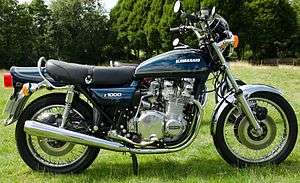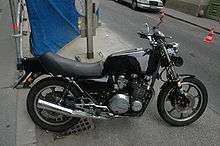Kawasaki Kz1000
 1977 Kawasaki Z1000 exhibited at classic car show in 2014 | |
| Manufacturer | Kawasaki |
|---|---|
| Parent company | Kawasaki Heavy Industries |
| Predecessor | KZ900 |
| Successor | KZ1100 |
| Engine |
1,015 cc (61.9 cu in) 4 stroke DOHC air cooled Inline 4, Bore x stroke 70.0 mm x 66.0 mm, Compression ratio 8.7:1 |
| Top speed | 132 mph (212 km/h)[1] |
| Power | 83 hp (62 kW) @ 8,000 rpm (1977), 90 hp (67 kW)(1978)[2] |
| Wheelbase | 1,505 mm (59.3 in) |
| Dimensions |
L: 2,210 mm (87 in) W: 880 mm (35 in) H: 1,200 mm (47 in) |
| Weight |
245.5 kg (541 lb)[1] (dry) 563 lb (255 kg)(½ tank)[1] (wet) |
| Fuel capacity | 16.7 l (4.4 US gal) |
| Fuel consumption | 45 mpg-US (5.2 L/100 km)[1] |
| Turning radius | 2.4 m (7.9 ft) |
| Related | Z 1000 Z1- R |
The Kawasaki Kz1000 or Z1000 is a motorcycle made in Japan by Kawasaki, released in September 1976 as a 1977 model to replace the KZ900/Z1 launched in 1972 in the Z series.[3] It has an inline-four cylinder engine and a 5-speed transmission, in a 'one down and four up' configuration. Producing about 90 hp, it was the fastest production motorcycle of the era.[1]
In 1979 Kawasaki introduced the Z 1300 liquid-cooled, 6-cylinder engine, which became the engine for the Voyager touring series. Both models were available for several years. The police model continued in production until 2005.
Model differences
Some of the significant differences between the Kz900 and the Kz1000 include that the latter of the two has a heavier crankshaft for less engine vibration, smoother acceleration and a larger displacement. There were various configurations of specifications and assembly, such as having the choice between chain-drive and shaft-drive. The more cruiser-like US version was called 1000 LTD in European markets.
Kawasaki swapped the traditional 4-4 exhaust (available on Z1 and Kz900) for the cheaper 4-2 exhaust. The Kz1000 came with either a chain or shaft drive after 1979. The frame on the Kz1000 is a very conventional featherbed design, but was not significantly changed in over 30 years of production.
Tires and rims
The Kz1000P (police) has 18 inch wheels with Dunlop run-flat tires. The front tire is size MN90-18, and the back tire is size MR90-18. They came in either a cast magnesium or chrome-plated wire spoke rims.
Accessories
The Kz1000 came optional with a Windjammer brand fairing, saddle bags, a sissy bar and highway bars, all of which were removable without any interference with performance or function. The fairing and saddle bags were molded fiber-glass resin made by Vetter, while the sissy bar and highway bar were chrome plated. Highway bars were also used for comfort on long trips that did not require constant shifting or braking and usually held additional lighting, in combination with the single 7 in (180 mm) halogen head lamp.

Police use
The Kz1000P was a police sub-model. It had a number of technical problems, including electromagnetic interference between some radios that caused problems for the ignition system. In addition, the combined set of equipment mounted at the rear (and particularly the placement of the radio on the rear rack) caused high-speed handling difficulties.
Motorsport

The Z1000 was successfully raced in European, Australian, American and British Superbike racing. A Z1000 ridden by Reg Pridmore won the AMA Superbike Championship in 1977 and 1978.[4] Pops Yoshimura first began to make his reputation in the mid-1970s by fielding fast, reliable Kawasaki Z1000s in the AMA Superbike championships.[5] Kawasaki Z1000s tuned by Mamoru Moriwaki were successfully raced in the Australian Superbike championships in the late 1970s by New Zealander Graeme Crosby.[6] John Cowie riding a Z1000 for the Pecket & McNab team, won the 1978 British ACU Formula One championship for production bikes.[7][8] Freddie Spencer rode a Z1000 during the 1979 AMA Superbike Championship, winning two races and finishing third in the final championship points standings.[9] Wayne Gardner and co-rider John Pace qualified their Moriwaki Kawasaki Z1000 on pole position at the prestigious 1981 Suzuka 8 Hours, ahead of all the major factory racing teams.[10] Also in 1981, Eddie Lawson won the AMA Superbike Championship for Kawasaki on a factory-backed Z1000S.[3]
Film and TV appearances
The Kz1000 was ridden by California Highway Patrol officers Ponch and Jon of the 1977–1984 TV show CHiPs. It was also in the anime TV series Great Teacher Onizuka, and ridden by Keanu Reeves the film Chain Reaction. Fourteen of the motorcycles in Mad Max (1979) were KZ1000s. The bikes were donated by a local Kawasaki dealer and modified in appearance by Melbourne business La Parisienne; one as a police bike ridden by 'The Goose', and thirteen more for members of the Toecutter's gang, played by a real motorcycle club called the Vigilantiesin.
Notes
- 1 2 3 4 5 Robert Smith (November–December 2009). "Kawasaki Kz1000 Z1-R". Motorcycle Classics. Retrieved 2009-11-11.
- ↑ Ker, Rod (2007), Classic Japanese Motorcycle Guide, Sparkford, UK: Haynes Publishing, pp. 126–127, ISBN 1-84425-335-X
- 1 2 "40 years of Kawasaki's 'Z' sleds". iol.co.za. Retrieved 1 February 2016.
- ↑ "Reg Pridmore at the Motorcycle Hall of Fame". motorcyclemuseum.org. Retrieved 1 February 2016.
- ↑ "Pops Yoshimura at the Motorcycle Hall of Fame". motorcyclemuseum.org. Retrieved 1 February 2016.
- ↑ "Wayne Gardner's 1980 Moriwaki Kawasaki". ma.org.au. Retrieved 1 February 2016.
- ↑ "Peckett and McNab, a brief history". f1network.net. Retrieved 1 February 2016.
- ↑ "British Motorcycle Champions - 1970s and 1980s". pressreader.com/uk/classic-motorcycle-mechanics. Retrieved 1 February 2016.
- ↑ "Freddie Spencer at the Motorcycle Hall of Fame". motorcyclemuseum.org. Retrieved 1 February 2016.
- ↑ "1981 Suzuka 8 Hours qualifying results". motoracing-japan.com. Retrieved 1 February 2016.
References
- Boehm, Mitch (August 19, 2015), "1982 Kawasaki Kz1000R ELR: The Eddie Lawson Replica; The Eddie Rep Remains Larger Than Life", Motorcyclist (magazine)
| Kawasaki motorcycle timeline, 1980s - next » | ||||||||||
|---|---|---|---|---|---|---|---|---|---|---|
| Year → Type ↓ |
1980s | |||||||||
| 1980 | 1981 | 1982 | 1983 | 1984 | 1985 | 1986 | 1987 | 1988 | 1989 | |
| Standard | (since 1976) Z650/KZ650 | |||||||||
| (since 1976) KZ750/LTD | ||||||||||
| (since 1976) KZ1000/LTD1000 | ||||||||||
| Z 1000 Z1-R | ||||||||||
| Z 1000 (A3/A4/MKII/FI/H/J/R) | ||||||||||
| Z 1100 R/R1 | ||||||||||
| Sport | GPZ1100 ('81–'82: B1/B2) | |||||||||
| GPz900R | ||||||||||
| GPz1000RX | ||||||||||
| Kawasaki Tomcat ZX-10 | ||||||||||
| GPz750 | ||||||||||
| GPz750 Turbo | ||||||||||
| Ninja 600R (thru to 1997) | ||||||||||
| Touring | (since 1979) KZ1300/Voyager | |||||||||
| GTR1000 Concours (thru to 2007) | ||||||||||
| Cruiser | 454 LTD | |||||||||
| EL250 | ||||||||||
| ZL900/ZL1000 Eliminator | ||||||||||